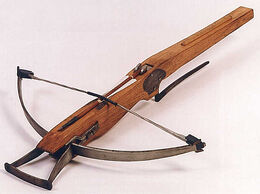(→Uses) Tag: sourceedit |
(→Uses) Tag: sourceedit |
||
| Line 20: | Line 20: | ||
Muskets were just as easy to use as crossbows but had superior armor penetration and smaller ammunition. During the early Renaissance the crossbow was considered outdated technology and its use slowly faded from battle and into hunting. |
Muskets were just as easy to use as crossbows but had superior armor penetration and smaller ammunition. During the early Renaissance the crossbow was considered outdated technology and its use slowly faded from battle and into hunting. |
||
| + | |||
| + | Some armies today do have modern crossbows for their special forces; primarily for special operations that involve silence. However gun suppressors, while not silent, are more relevant as they can be used on guns that can easily outperform crossbows. The [[Viet Cong]] did create booby-traps involving crossbows triggered by trip-wires. |
||
==Trivia== |
==Trivia== |
||
Revision as of 11:14, 9 September 2017

"The original sniper rifle."
--David Coretti, Knight expert
The Crossbow was a projectile weapon of the Middle Ages. It was the Long-Range weapon of the Knight.
Description
The crossbow consisted of a bow mounted onto a wooden stock. When spanned, the bowstring is held in place by a notch. When the trigger is lifted up, it pushes the bowstring from the notch. Because of the forward motion of the bowstring, there is no recoil.
Stats
- Long Range
- Bow span: 3 feet
- 9 lbs
- Wood frame, steel string.
Uses
The crossbow was widely used due to its accuracy, its ease of use, and ability to pierce armor. The main drawback of the crossbow was the long time it took to reload, often requiring the use of a crannequin.
The first crossbows were created in East Asia and were commonly used by the Chinese. The technology traveled westward, allowing the Greeks and Romans to develop their own variations of the weapon.
Medieval Europe preferred the crossbow to the normal bow and arrow because of how easy it was to master, and many crossbows could fire their projectiles with more force than a bow: allowing superior armor penetration. The English were one of the few nations in Europe to prefer the longbow over the crossbow. Many bows and archers were seen as cowardly and inferior to the common foot soldier, discouraging bow archers. Because of this, most mainland European armies lacked skillful archers and were dependent on the crossbow.
It is generally agreed that Crossbows are superior to Bows in sieges as Crossbows did not require the archer to strain himself while aiming for enemy units to appear. However the English Longbows showed superior range on open battlefields; as seen in the Battle of Crecy in 1346.
Muskets were just as easy to use as crossbows but had superior armor penetration and smaller ammunition. During the early Renaissance the crossbow was considered outdated technology and its use slowly faded from battle and into hunting.
Some armies today do have modern crossbows for their special forces; primarily for special operations that involve silence. However gun suppressors, while not silent, are more relevant as they can be used on guns that can easily outperform crossbows. The Viet Cong did create booby-traps involving crossbows triggered by trip-wires.
Trivia
- The Second Lateran Council under Pope Innocent II in 1139 banned the use of crossbows against Christians as they deemed it to be too powerful and lethal (though Muslims and other non-Christians were allowed to be killed by crossbows). However the crossbow was so effective as a weapon that the ban was ignored.